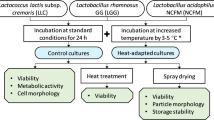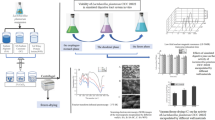Abstract
Lactic acid bacteria (LAB) were encapsulated with alginate, gelatin and trehalose additives by the extrusion method and dried at 4 °C. The microcapsules were generally spherical and had a wrinkled surface with a size of 1.7 mm ± 0.2 mm. Trehalose as a carbohydrate source in the culture medium could reduce acid production and performed no function in the positive proliferation of LAB. Using trehalose as a carbohydrate source and protective medium simultaneously had a benefit in the protection of LAB cells during the storage at 4 °C. The density of live LAB cells could be 107 CFU g−1 after 8 weeks of storage. Cells of LAB could be continuously released from the capsules from the acidic (pH 1.2) to neutral conditions (pH 6.8). The release amounts and proliferation speeds of LAB cells in neutral medium were much larger and faster than those in acidic conditions. Additionally, immobilization of LAB could improve the survival of cells when they were exposed to acidic medium (pH 1.2) with a survival rate of 76 %.
Similar content being viewed by others
References
Adhikari, K., Mustapha, A., Grün, I. U., and Fernando, L., 2000. Viability of microencapsulated bifidobacteria in set yogurt during refrigerated storage. J. Dairy Sci., 83(9): 1946–1951.
Bajpai, S. K., Saxena, S. K., and Sharma, S., 2006. Swelling behavior of barium ions-crosslinked bipolymeric sodium alginate-carboxymethyl guar gum blend beads. React. Funct. Polym., 66(6): 659–666.
Chan, E. S., and Zhang, Z., 2005. Bioencapsulation by compression coating of probiotic bacteria for their protection in an acidic medium. Proc. Biochem., 40(10): 3346–3351.
Chandramouli, V., Kailasapathy, K., Peiris, P., and Jones, M., 2004. An improved method of micro-encapsulation and its evaluation to protect Lactobacillus. spp. in simulated gastric conditions. J. Microbiol. Methods, 56(11): 27–35.
Cho, Y. J., Park, O. J., and Shin, H. J., 2006. Immobilization of thermostable trehalose synthase for the production of trehalose, Enzyme Microb. Technol., 39(1):108–113.
Femia, A. P., Luceri, C., Dolara, P., Giannini, A., Biggeri, A., Salvadori, M., et al., 2002. Antitumorigenic activity of the prebiotic inulin enriched with oligofructose in combination with the probiotics Lactobacillus rhamnosus and Bifidobacterium lactis on azoxymethaneinduced colon carcinogenesis in rats. Carcinogenesis, 23(11): 1953–1960.
Kailasapathy, K., and Chin, J., 2000. Survival and therapeutic potential of probiotic organisms with reference to Lactobacillus acidophilus and Bifidobacterium spp. Immunol. Cell Biol., 78(1): 80–88.
Krasaekoopt, W., Bhandari, B., and Deeth, H., 2003. Evaluation of encapsulation techniques of probiotics for yoghurt. Intern. Dairy J., 13(1): 3–13.
Ouwehand, A. C., and Salminen, S. J., 1998. The health effects of cultured milk products with viable and non-viable bacteria. Intern. Dairy J., 8(9): 749–758.
Picot, A., and Lacroix, C., 2004. Encapsulation of bifidobacteria in whey protein-based microcapsules and survival in simulated gastrointestinal conditions and in yoghurt. Intern. Dairy J., 14(66): 505–515.
Prevost, H., and Divies, C., 1992. Cream fermentation by a mixed culture of lactococci entrapped in two-layer calcium alginate gel beads. Biotechnol. Lett., 14: 583–588.
Rafter, J., 2002. Lactic acid bacteria and cancer: Mechanistic perspective. British J. Nutr., 88(1S): 89–94.
Romano, A. H., and Conway, T., 1996. Evolution of carbohydrate metabolic pathways. Res. Microbiol., 147(6): 448–455.
Zayed, G., and Roos, Y. H., 2004. Influence of trehalose and moisture content on survival of Lactobacillus salivarius subjected to freeze-drying and storage. Proc. Biochem., 39(99): 1081–1086.
Author information
Authors and Affiliations
Corresponding author
Rights and permissions
About this article
Cite this article
Li, X., Chen, X. Drying of micro-encapsulated lactic acid bacteria — Effects of trehalose and immobilization on cell survival and release properties. J. Ocean Univ. China 8, 39–44 (2009). https://doi.org/10.1007/s11802-009-0039-3
Received:
Revised:
Accepted:
Published:
Issue Date:
DOI: https://doi.org/10.1007/s11802-009-0039-3




